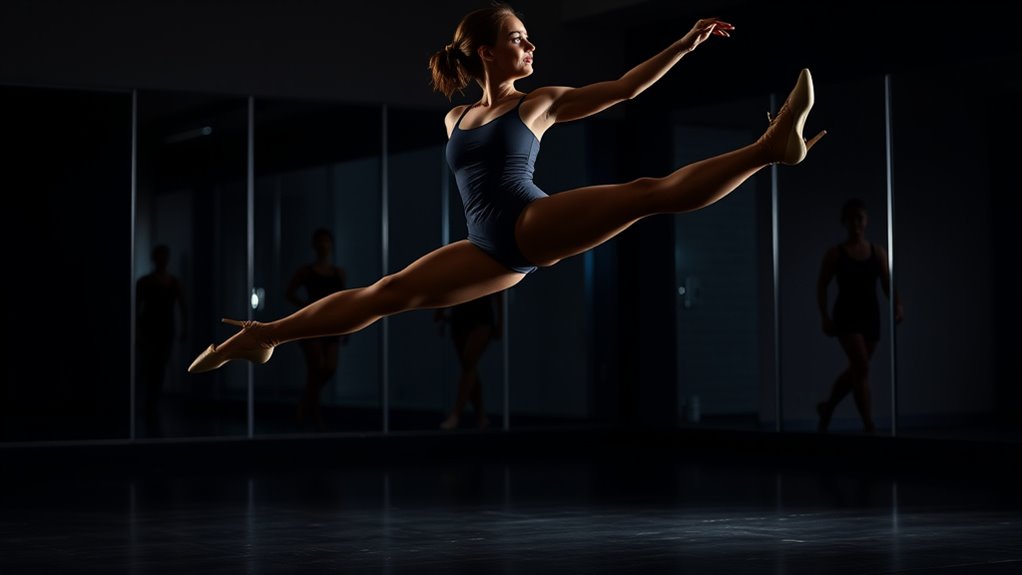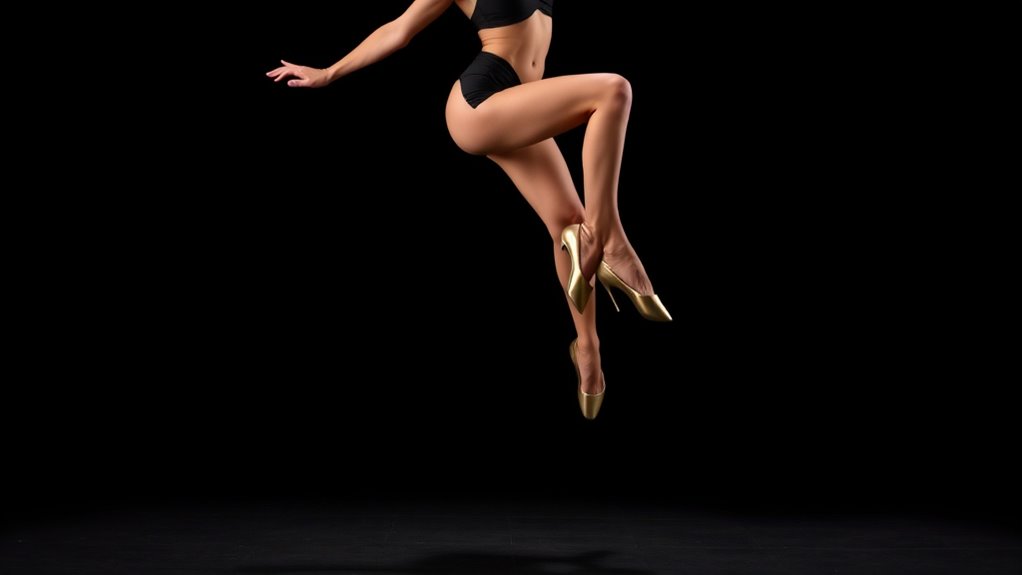Professional dancers perform in high heels by mastering balance, strength, and focus. You’ll find that their stability comes from proper weight distribution and core engagement, while ankle mobility allows for fluid movements. They also build endurance through targeted strength training and flexibility exercises. Confidence is key, as elevated shoes enhance presence and self-expression. If you think you’re ready to learn more about the nuances of dancing in heels, there’s plenty more to explore.
The Art of Dancing in Heels

Dancing in heels is both an art and a science, requiring not just skill but also a keen understanding of balance and body mechanics. When you step onto the dance floor in high heels, you’re not just showcasing your moves; you’re engaging in heel choreography that transforms your entire presence. The way you position your feet, shift your weight, and execute each step creates a visual language that speaks volumes about your artistry.
Heel aesthetics play an essential role in this performance, as they enhance your silhouette and heighten your movements. Every pivot and turn becomes a statement, accentuated by the shoes that elevate your stance. Mastering this form of dance involves more than technique; it’s about embodying confidence and fluidity. You’ll find that the synergy of heel choreography and heel aesthetics creates a mesmerizing experience, drawing your audience into the story you’re telling through movement.
Essential Techniques for Stability
While mastering the art of dancing in heels, maintaining stability is essential to executing your moves with grace and confidence. One of the key factors in achieving this stability is your foot placement. You should focus on distributing your weight evenly across the ball of your foot, ensuring a solid foundation for each step. Experimenting with different foot angles can also help find your balance point.
Additionally, ankle mobility plays a significant role in how well you perform. Flexible ankles allow for better shock absorption and more fluid movements, reducing the risk of injury. Incorporate ankle stretches and mobility exercises into your routine to enhance your range of motion.
Finally, pay attention to your posture. Keeping your core engaged and shoulders back not only aids in balance but also projects confidence. By consciously applying these techniques, you’ll find yourself dancing in heels with newfound poise and stability.
Building Strength and Endurance

To truly excel in dancing in heels, building strength and endurance is essential, as these attributes directly impact your performance and longevity in the art. Strength training is critical; it not only helps you maintain control but also supports your joints, reducing the risk of injury. Focus on exercises that target your core, legs, and ankles—these areas are important for stability and power while dancing. Incorporate squats, lunges, and calf raises into your routine to develop the necessary muscle groups.
Endurance exercises, like interval training or circuit workouts, will enhance your stamina, allowing you to perform longer without fatigue. As you increase your endurance, you’ll find it easier to maintain your energy levels during performances and rehearsals. By consistently engaging in these practices, you’ll build the physical foundation required to dance confidently in heels and elevate your overall performance.
Finding the Perfect Pair of Heels
Finding the right pair of heels can make all the difference in your performance and comfort as a dancer. The perfect heel selection involves considering not just the style, but also how well they fit your foot. When you’re dancing, you want to feel secure and stable, so size fitting is vital.
Here’s a quick guide to help you choose:
| Aspect | Importance |
|---|---|
| Heel Height | Affects balance and posture |
| Material | Influences flexibility and grip |
| Toe Shape | Determines comfort and support |
| Width | Guarantees stability and reduces pain |
| Arch Support | Provides essential foot support |
The Role of Core Engagement

When you dance in high heels, core engagement isn’t just important; it’s essential for maintaining balance and stability. Without a strong core, your movements can become unsteady, making it challenging to execute techniques effectively. Learning how to activate your core can transform your performance, allowing you to shine with confidence and grace.
Importance of Core Stability
Core stability is essential for professional dancers, especially those performing in high heels, where balance and precision are paramount. When you’re dancing, your core strength acts as the foundation for every movement, enabling you to maintain control and poise. Without a stable core, your body can easily lose alignment, making it challenging to execute intricate steps. Stability training helps you develop this core strength, ensuring that your muscles work harmoniously to support your spine and pelvis. Engaging your core allows for smoother shifts and dynamic performances, reducing the risk of injuries. Ultimately, a strong core enhances your ability to perform confidently in high heels, allowing you to focus on artistry rather than struggling to stay balanced.
Techniques for Core Activation
Achieving ideal core stability is only part of the equation; knowing how to effectively activate your core can greatly enhance your performance. Core breathing is a crucial technique that not only strengthens your abdominal muscles but also promotes better pelvic alignment. As you inhale deeply, visualize expanding your ribcage while engaging your lower abdominals. This connection helps stabilize your pelvis, allowing for fluid movements even in high heels. Additionally, practicing pelvic tilts can further enhance this alignment, ensuring your body remains balanced and poised. By integrating these techniques, you’ll find that your overall dance performance improves, making it easier to execute complex routines with grace and confidence. Remember, a strong, engaged core is the foundation of every enchanting dancer.
Mastering Balance and Posture
Although mastering balance and posture may seem intimidating, it’s essential for professional dancers in high heels to develop these skills to enhance their performance. Achieving proper posture alignment is vital; it allows you to distribute weight evenly and maintain stability. Start by engaging your core as you stand tall, keeping your shoulders back and head held high.
Incorporating specific balance techniques, like practicing on one leg or using a wall for support, can greatly improve your stability in heels. As you gain confidence, try shifting your weight from one foot to the other, all while maintaining your posture. This dynamic practice not only strengthens your muscles but also refines your sense of equilibrium. Remember, the more you focus on these elements, the more natural they’ll become. With dedication, you’ll find that mastering balance and posture transforms your performance, allowing you to express yourself more freely and confidently on stage.
Incorporating Heels Into Dance Training
Having a solid foundation in balance and posture provides a great advantage when incorporating heels into your dance training. As you shift into heel dance styles, it’s crucial to embrace both the elegance and the challenges that come with dancing in heels. Integrating heel-specific stretches into your routine can considerably enhance your performance and comfort.
Consider focusing on these emotional elements:
- The thrill of mastering a new skill
- The confidence that comes from looking polished
- The empowerment of expressing yourself through movement
- The joy of connecting with your audience
- The satisfaction of overcoming obstacles
Overcoming Common Challenges
While dancing in heels can elevate your performance to new heights, it also presents unique challenges that require thoughtful strategies to overcome. One of the first steps is heel selection; choosing the right pair can greatly impact your balance and control. Opt for shoes that provide adequate support and stability, ensuring they align with your foot’s natural structure.
Next, focus on injury prevention. Strengthening your ankles and feet through targeted exercises can help you adapt to the demands of dancing in heels. Incorporating flexibility routines will also assist in maintaining your range of motion, reducing the risk of strains.
Finally, practice is key. Spend time in your chosen heels to build muscle memory and enhance your comfort level. By addressing these challenges head-on, you’ll not only improve your performance but also enjoy a safer and more confident dancing experience in heels.
The Psychological Aspect of Performing in Heels
When you slip on a pair of high heels, you’re not just changing your height; you’re transforming your entire mindset. The added elevation can boost your confidence, helping you command the stage with presence and poise. But as you perform, you might also find yourself grappling with fears, requiring intense focus to channel that energy into your movements.
Confidence Boosting Effects
Elegance often transforms into empowerment for dancers who perform in high heels, as the psychological effects of donning these stylish shoes extend far beyond aesthetics. The act of wearing heels can lead to significant confidence enhancement, allowing for a powerful form of self-expression. When you slip into those heels, you might experience:
- A heightened sense of poise
- Increased body awareness
- Amplified charisma on stage
- A stronger connection with your audience
- An invigorated self-image
These elements combine to create a compelling presence, making you feel unstoppable. It’s not just about the shoes; it’s about how they elevate your spirit and amplify your performance. In this transformative space, you discover not just a dancer, but a more confident, expressive version of yourself.
Focus and Mindset
As you step onto the stage in high heels, your focus sharpens, and your mindset shifts into a heightened state of awareness. This transformation isn’t just physical; it’s psychological. Cultivating a focused mindset helps you channel energy into performance, reinforcing your mental resilience against any distractions.
| Element | Impact on Performance |
|---|---|
| Concentration | Enhances precision in movements |
| Visualization | Boosts confidence and clarity |
| Positive Self-Talk | Reduces anxiety and fosters enjoyment |
Overcoming Fear Factors
While performing in high heels can evoke a mix of excitement and trepidation, understanding and addressing the underlying fear factors is essential for any dancer. By focusing on effective fear management and anxiety reduction techniques, you can transform those nerves into confidence. Consider the following aspects:
- The fear of losing balance
- Concerns about injury or falls
- Anxiety over judgment from peers or the audience
- Doubts about skill level or technique
- Pressure to meet performance expectations
Acknowledging these fears allows you to confront them head-on. Embrace visualization techniques, practice in safe environments, and remind yourself of past successes. By doing so, you’ll not only enhance your performance but also find empowerment in those towering heels.
Frequently Asked Questions
What Types of Heels Are Best for Beginners?
When stepping into the world of heels, you’ll want styles that cradle your feet with beginner comfort and offer heel stability. Look for chunkier designs or lower heights to help you glide gracefully at first.
How Do Dancers Prevent Injuries While Wearing Heels?
To prevent injuries while dancing in heels, you’ll need proper heel training, focusing on balance and strength. Incorporating exercises that enhance flexibility and core stability can greatly aid in injury prevention, ensuring a safer performance.
Can Dancing in Heels Improve Overall Dance Skills?
Imagine mastering a stunning routine in heels. Dancing in heels can enhance your balance training and core strength, pushing your skills to new heights and refining your technique, ultimately improving your overall dance performance.
How Do Performers Choose Heel Height for Specific Routines?
When you’re selecting heel height, consider heel selection strategies that align with your routine performance dynamics. A shorter heel offers stability for intricate footwork, while a taller one enhances lines and elegance in fluid movements.
What Are Common Misconceptions About Dancing in Heels?
Many think dancing in heels is just about style, but it’s more about heel comfort and mastering balance techniques. Misconceptions often overlook the skill and training needed to gracefully navigate challenges while performing.


